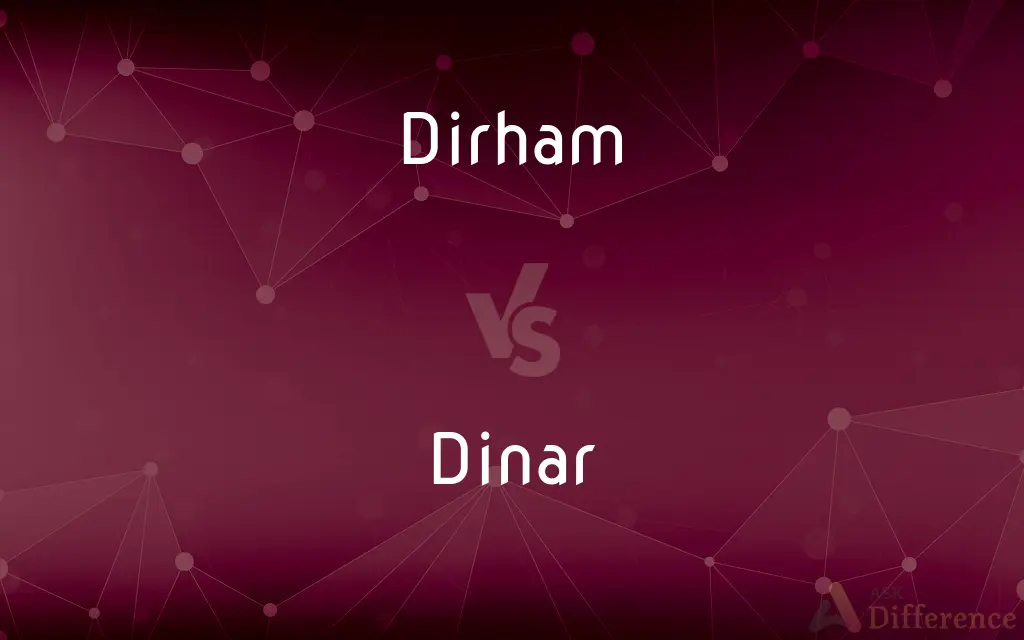Dirham vs. Dinar — What's the Difference?
By Urooj Arif & Fiza Rafique — Updated on March 9, 2024
Dirham is a currency used in several Arab nations, emphasizing smaller value units, while Dinar signifies larger value currency in Middle Eastern countries.

Difference Between Dirham and Dinar
Table of Contents
ADVERTISEMENT
Key Differences
The Dirham is a currency unit used in countries like the United Arab Emirates and Morocco, valued for everyday transactions and smaller denominations. It's often subdivided into 100 smaller units, such as fils in the UAE. The Dinar, on the other hand, is the principal currency in nations such as Kuwait, Bahrain, and Jordan, recognized for its higher value relative to many currencies. It typically has a higher exchange rate, reflecting these countries' economic statuses.
While the Dirham circulates in a coin and banknote form, catering to a wide range of transactions from minor purchases to significant expenses, the Dinar, given its higher value, is predominantly used in larger transactions and savings. This distinction influences the physical currency's design and denominations available to consumers.
The history of the Dirham traces back to ancient times, originally denoting a unit of weight used for silver coins. This historical context reflects its long-standing use in trade and commerce within and beyond the Arab world. The Dinar's roots are equally historical, derived from the Roman denarius, signifying its deep cultural and economic significance in the region it serves.
Economically, countries using the Dirham typically have diversified economies, including tourism, trade, and natural resources, which affect the currency's stability and value. In contrast, Dinar-using countries often possess significant oil reserves, impacting their economic health and, consequently, the Dinar's strength and stability.
Regarding international exchange, the Dirham is widely traded, supporting the bustling trade and tourism sectors of its countries. The Dinar, with its higher value, plays a crucial role in global oil markets, influencing its exchange rates and investment attractiveness.
ADVERTISEMENT
Comparison Chart
Countries
UAE, Morocco, etc.
Kuwait, Bahrain, Jordan, etc.
Subdivision
100 fils or similar
1,000 fils or similar
Value
Generally lower
Generally higher
Usage
Everyday transactions, small to large amounts
Larger transactions, high-value purchases
Historical Origin
Ancient unit of weight for silver
Roman denarius
Compare with Definitions
Dirham
A unit of currency in various Arab countries.
The price of the coffee was 15 Dirhams in Dubai.
Dinar
Has a historical significance dating back to the Roman denarius.
The Dinar's name reflects its ancient lineage.
Dirham
Historically derived from a unit of weight.
Ancient traders measured silver in Dirhams.
Dinar
A higher value currency in Middle Eastern countries.
In Kuwait, one Dinar is worth several dollars.
Dirham
Used for both coins and banknotes.
She paid with a 100 Dirham banknote for her purchase.
Dinar
Influences the global oil market.
Bahrain's economy impacts the Dinar's value on international markets.
Dirham
Represents smaller transactions and savings.
The souvenir cost me a few Dirhams in Morocco.
Dinar
Tied to countries with significant oil reserves.
The Dinar strengthens as oil prices rise.
Dirham
Influenced by diversified economies.
The Dirham's value fluctuates with UAE's economic changes.
Dinar
Primarily used in larger transactions.
Real estate prices are often quoted in Dinars.
Dirham
The dirham, dirhem or dirhm (Arabic: درهم) was a silver coin, and, in some cases, still is a unit of currency in several Arab states. It was also the related unit of mass.
Dinar
The dinar () is the principal currency unit in several countries near the Mediterranean Sea, and its historical use is even more widespread. The modern dinar's historical antecedents are the gold dinar, the main coin of the medieval Islamic empires, first issued in AH 77 (696–697 CE) by Caliph Abd al-Malik ibn Marwan.
Dirham
See Table at currency.
Dinar
See Table at currency.
Dirham
A unit of currency equal to one one-thousandth of the dinar in Libya and Sudan.
Dinar
Any of several units of gold and silver currency formerly used in the Middle East.
Dirham
A unit of currency used in the Arab world, currently the name of the currency of Morocco and the United Arab Emirates.
Dinar
The official currency of several countries, including Algeria, Bahrain, Iraq, Jordan, Kuwait, Libya, Serbia, Tunisia and (as denar) North Macedonia.
Dirham
: a former Turkish unit of weight.
Dinar
(historical) An ancient Arab gold coin of 65 grains in weight.
Dirham
100 dirhams equal 1 riyal
Dinar
A petty money of accounts of Persia; 100 dinars consituted a rial.
Dirham
The basic unit of money in the United Arab Emirates; equal to 1,000 fils
Dinar
An ancient gold coin of the East, issued by various Islamic countries.
Dirham
The basic unit of money in Morocco; equal to 100 centimes
Dinar
The unit of currency of Yugoslavia. One dinar equals 100 paras. Abbreviated Din.
Dirham
100 dirhams equal 1 dinar
Dinar
100 dinars equal 1 rial
Dirham
100 dirhams equal 1 dinar
Dinar
The basic unit of money in Yugoslavia
Dirham
Worth one tenth of a Kuwaiti dinar; equal 100 fils
Dinar
The basic unit of money in Tunisia
Dinar
The basic unit of money in Libya
Dinar
The basic unit of money in Kuwait; equal 1,000 fils
Dinar
The basic unit of money in Jordan; equal to 1,000 fils
Dinar
The basic unit of money in Iraq; equal to 1,000 fils
Dinar
The basic unit of money in Bahrain; equal to 1,000 fils
Dinar
The basic unit of money in Algeria
Common Curiosities
What historical influences do the Dirham and Dinar have?
The Dirham is influenced by ancient units of weight for silver, while the Dinar has roots in the Roman denarius.
How do the economies of Dirham-using countries differ from those using the Dinar?
Dirham-using countries often have diversified economies, while Dinar-using countries may heavily rely on oil reserves.
What countries use the Dirham?
The United Arab Emirates and Morocco are examples of countries using the Dirham.
Can you use Dirhams in Dinar-using countries?
No, Dirhams are not accepted in countries that use the Dinar; currency exchange is required.
What are the denominations of Dirhams and Dinars?
Dirhams are subdivided into 100 fils, whereas Dinars are typically divided into 1,000 fils.
How do the exchange rates of Dirhams and Dinars compare internationally?
Dinars usually have higher exchange rates internationally due to their stronger economic backing.
What is the value of a Dinar compared to a Dirham?
The Dinar generally has a higher value compared to the Dirham, reflecting in their exchange rates.
Why is the Dinar valued higher than the Dirham?
The Dinar's higher value is often due to the economic wealth and oil reserves of the countries that use it.
Can tourists easily exchange Dirhams to Dinars and vice versa?
Yes, currency exchange services are available, but the rates vary by location and time.
What is the global impact of the Dinar?
The Dinar impacts global oil markets and investment flows due to the economic status of its countries.
How do people typically use Dirhams in daily life?
Dirhams are used for a wide range of purchases, from small everyday items to larger transactions.
What influences the value of the Dirham and Dinar?
Economic factors, including diversification and oil reserves, influence their values.
How does the design of Dirham and Dinar currencies reflect their usage?
The design and denominations cater to their respective transaction sizes and economic contexts.
Is the Dinar more stable than the Dirham?
Stability can vary, but the Dinar often shows high stability due to the oil-rich economies of its countries.
Do Dirham and Dinar have historical significance?
Yes, both currencies have deep historical roots, reflecting their importance in regional trade and economy.
Share Your Discovery

Previous Comparison
Emitted vs. Remitted
Next Comparison
Disapparate vs. DisapparatedAuthor Spotlight
Written by
Urooj ArifUrooj is a skilled content writer at Ask Difference, known for her exceptional ability to simplify complex topics into engaging and informative content. With a passion for research and a flair for clear, concise writing, she consistently delivers articles that resonate with our diverse audience.
Co-written by
Fiza RafiqueFiza Rafique is a skilled content writer at AskDifference.com, where she meticulously refines and enhances written pieces. Drawing from her vast editorial expertise, Fiza ensures clarity, accuracy, and precision in every article. Passionate about language, she continually seeks to elevate the quality of content for readers worldwide.















































